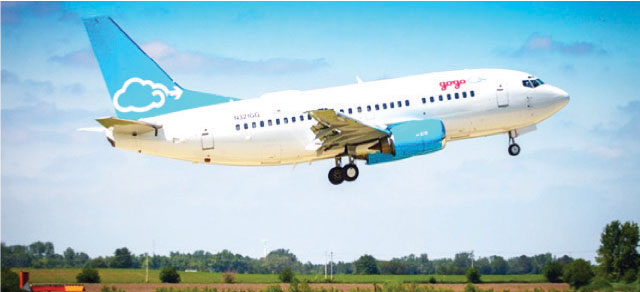For years, people have cursed lousy, expensive Wi-Fi on airplanes, with most of the ire directed at Gogo, the largest player in the field.
Soon there may be fewer f-bombs dropped at 35,000 feet. Gogo is maturing into the world of broadband satellite coverage in a technology shift that will offer fliers greater bandwidth and vastly broader geographic coverage.
“Bandwidth equals revenue. Bandwidth equals better customer service,” Chief Executive Officer, Michael Small, said in an interview at Gogo’s downtown Chicago headquarters. “It’s literally that simple.”
The new system is called 2Ku, because it offers two antenna arrays to receive and send on the Ku band spectrum. Gogo says its system protrudes only 6.5 inches above the airframe, reducing drag.
Gogo demonstrated 2Ku for reporters aboard its Boeing 737 test airplane – dubbed Jimmy Ray, after the company’s founder – with two flights around Indiana.
Two dozen aviation and technology reporters trooped aboard Jimmy Ray with an arsenal of gadgets, eager to hurl the most data-intensive activities – Netflix, Facetime, YouTube, Periscope – at Gogo’s new technology.
It was a small horde of “data-hungry journalists on board all trying to kill the system,” said Jason Rabinowitz, manager of data research for Routehappy, a travel startup.
Gogo’s new product acquitted itself admirably, with high-definition YouTube videos streaming just fine.
The biggest hiccup on the test flight appeared to be page-load latency, a bit of a hesitation before many Web pages loaded. Once loaded, they worked fine, too.
Gogo touts the dual-band Ku service as capable of delivering top speeds of 70 megabits per second, compared with the 9.8 Mbps of its former speed leader, a ground-based technology called ATG4.
Over time, as satellite-beaming techniques are perfected, 100 Mbps will be possible, Small said.
Two other big questions remain.
How will the system fare on flights with hundreds of gadget-toting passengers? The company says it has stressed 2Ku on numerous test flights with dozens of devices across a range of locations and hasn’t found bandwidth problems.
What will airlines charge for it? Unless you’re sitting in first class, free is almost certainly not on the price menu. Small said the company isn’t ready to discuss pricing.
Aeroméxico received regulatory certification in November 2015 and began flying the first 2Ku-equipped jets within weeks, followed by Virgin Atlantic.
Delta Air Lines is the largest United States customer to sign up for the service; a portion of its fleet should have faster Wi-Fi speeds in 2016.
The bulk of Gogo’s 550-plane 2Ku backlog from eight airline customers will be completed in 2017 and 2018, Small said.
The new service was announced in April 2014 and is hitting the aviation market as Gogo’s dominance of the in-flight Wi-Fi industry is under assault by several rivals, including ViaSat, Panasonic, and Global Eagle Entertainment.
Gogo was launched in 2011 but grew out of Aircell, the seat-back phone of the 1990s.
It posted revenue of $126 million for the third quarter 2015, up 22 per cent from a year earlier, and a net loss of $29 million.
Gogo has struggled with its ground-based cell towers, which can’t match the speed of a satellite connection.
The lack of capacity has forced it to charge as much as $40 on some flights, which helps reserve bandwidth for the passengers who will pay for it.
The turn toward satellite is also the only way Gogo could ever hope to credibly expand its franchise outside the U.S. Greater bandwidth is long overdue for both customers and shareholders.
Gogo shares were down 5 per cent last year.
Unlike Gogo, ViaSat owns and operates its own satellites and has used that business – and customers’ frustration with Gogo – to edge into the in-flight Wi-Fi market.
It has equipped JetBlue’s fleet and large portions of United Airlines’ fleet, and is making a big push worldwide.
ViaSat’s Ka-band system is offered free on JetBlue (funded by Amazon.com) with speeds that can top the new Gogo system.
But Gogo contracts with multiple satellite providers for 2Ku, which gives the company much greater geographic coverage around the globe than ViaSat enjoys. Gogo says the 2Ku system will cover 98 per cent of commercial tracks. It won’t work on routes that traverse the Arctic Circle, including many U.S.-Asia flights.
Beyond consumer uses, Gogo sees higher bandwidth as the gateway to a range of new business opportunities, from greater tools for pilots to aircraft maintenance monitoring.
Within 20 years, Small said, such data transmission will make up the largest aspect of Gogo’s revenue, surpassing consumer Wi-Fi access.
“If anything needs to be connected,” Small said, “it’s an aircraft.”
• Culled from www.bloomberg.com

- Advertisement -
- Advertisement -
Must Read
Police invite and detain school principal over Ibadan kids’ deaths, Ooni’s...
Police invite NS detain school principal over Ibadan kids’ deaths at end-of-year funfair
By Jeph Ajobaju, Chief Copy Editor












